2015 Can-Am Spyder F3 Review
Less snowmobile, more roadster
My first drag down the airport runway aboard Can-Am’s new 2015 Spyder F3 was accompanied by the unmistakable sound of tire squeal and the smell of torched rubber. This was not, however, the result of dumping the clutch at high RPMs on the base model’s six-speed manual transmission. This was the up-spec F3-S with the SE6 semi-automatic transmission. Nothing but horsepower, baby! Intrigued?
2015 Can-Am Spyder F3
| Engine | 18.0/20 |
| Suspension/Handling | 12.5/15 |
| Transmission/Clutch | 8.0/10 |
| Brakes | 9.5/10 |
| Instruments/Controls | 5.0/5 |
| Ergonomics/Comfort | 9.5/10 |
| Appearance/Quality | 9.0/10 |
| Desirability | 7.5/10 |
| Value | 8.0/10 |
| Overall Score | 87/100 |
The new F3 is motivated by the same 1330cc Rotax Triple introduced on the Spyder RT last year. But where the RT maintains algorithms that maximize the invasiveness of the vehicle’s Stability Control System (SCS) and Traction Control System (TCS), the F3’s electronics aren’t as burdened, allowing for a more playful Spyder. Don’t begin entertaining ideas about entering the F3 in a drift contest. The new algorithms provide for ample straight-line wheelspin, but once you introduce lateral cornering forces into the equation, SCS and TCS kick into action before antics get out of hand. Smartly, though, where other Spyder models shut down the fun with more immediacy than cops at a high school kegger, the F3’s algorithms interject in a more linear fashion, allowing for an elevated level of mid-corner fun.
2015 Polaris Slingshot Review – First Ride/Drive + Video
For now, these new algorithms are specific to the F3 and are the main reason why the F3 is easily my favorite Spyder. But there’s more significance to the new model Spyder. A lot more.
Redesigned bodywork lessens the Spyder’s snowmobile-with-wheels connotation by exposing a portion of the Rotax Triple, while the new tubular steel frame and swingarm act as stylized industrial art. Not only do these changes up the F3’s visual appeal, but also help endear the F3 to the cruiser crowd Can-Am is courting.
Yep, I said cruiser crowd. The F3 is meant to fill a void in the Spyder line-up, appealing to cruiser riders by way of its relaxed, feet-forward seating position. This should be exciting to many prospective Spyder owners, but it gets better. The new seating position is customizable to body size and personal preference. The F3’s “UFit” system allows for five-way adjustable footpegs and a variety of handlebars with varying degrees of length and rise.
When a person enters a Spyder dealership, they will be able to sit on an F3 Spyder and experience the different ergonomics prior to purchasing. According to Can-Am, the procedure to swap the handlebar and adjust the footpegs is a 10-minute process. The positioning can be altered at a future point by buying a different handlebar and/or the appropriate length linkage for the brake pedal (the five predetermined footpeg positions are accompanied by corresponding brake linkage lengths, $29.99 each).
Ironically, the relaxed, feet-forward seating position, while comfortable, also helps when pushing the F3 through corners. Unlike the other Spyders, where the standard footpeg positioning requires more upper body strength to manipulate the Spyder through a series of corners, the leverage provided by the feet forward positioning allows an F3 rider to brace himself against cornering G forces with leg muscles. Using one’s legs, an F3 rider can maintain a lighter grip on the handlebar during both cornering as well as braking. This allows for better handlebar input and vehicle control.
Like other Spyder models in the Can-Am lineup, the F3 comes in two versions; a standard model for $19,499 and an F3-S model for $20,999. What the $1500 upgrade to the S model gets you is cruise control, machined front wheels, a suede seat with red stitching, stylized front fenders with integrated LED lighting, and special accents and badging. Both trim levels are available with manual or SE6 semi-automatic transmissions.
Clutch pull on the standard transmission is significantly stiff. I preferred the SE6 semi-automatic transmission which only requires pushing a button with your left thumb to upshift. You can manipulate downshifts manually, but the SE6 will automatically downshift if you don’t. The SE6 is a $1500 option, but it’s well worth the price.
The Rotax Triple pounds out heaps of mid-range torque and rapidly spins up until gently bouncing off the rev limiter. The ACE engine emits a wonderful intake growl and three-cylinder exhaust wail, prompting its rider to twist the throttle at every opportunity. There is a slight hesitation between cracking the ride-by-wire throttle and receiving engine response. Not horrible, but noticeable. The cruise control can be set randomly or in more precisely selectable two-MPH increments.
Mash on the right foot pedal and the F3’s ABS brakes slow the 850-pound (claimed dry weight) Spyder F3-S with authority. To provide lighter steering, weight was shifted rearward, lightening the load on the front two wheels. At 7.1 gallons, the F3 has more fuel capacity than either the ST (6.6 gal.) or the RT (6.9 gal.).
As much of an improvement as the new F3-S is over previous Spyders, I’d like to see Can-Am provide selectable Rider Modes, giving the operator a choice of how much electronic oversight he wants from his Spyder. The F3’s new algorithms are an improvement, but the Spyder still resides in a nanny state of conservative anti-hooliganism.
Colors for the standard F3 are Steel Black Metallic and Pearl White, while the F3-S is available in Steel Black Metallic, Pearl White/Steel Black Metallic, Pure Magnesium Metallic/Steel Black Metallic, Can-Am Red Solid Gloss/Steel Black Metallic.
Spyder F3-S Specifications | |
| MSRP | $20,999 (as tested: $22,499) |
| Engine Type | 1330cc liquid-cooled Rotax ACE Triple |
| Bore and Stroke | 84.0 x 80.0 mm |
| Fuel System | EFI |
| Ignition | Digital |
| Horsepower | 115 hp @ 7250 rpm (claimed) |
| Torque | 96 lb-ft @ 5000 rpm (claimed) |
| Transmission | 6-speed manual, or semi-automatic |
| Final Drive | Belt |
| Front Suspension | Double A-arm, Fox shocks with 58.07 inches of travel |
| Rear Suspension | Sachs monoshock with 5.20 inches of travel |
| Front Brake | 2 x 270 mm discs with radially mounted Brembo monobloc calipers |
| Rear Brake | 270 mm disc with radially mounted Brembo caliper |
| Front Tire | 165/55-15 |
| Rear Tire | 225/50-15 |
| Wheelbase | 67.3 inches |
| Seat Height | 26.6 inches |
| Claimed Dry Weight | 850 lb. |
| Fuel Capacity | 7.1 gal. |
| Available Colors | F3: Steel Black Metallic and Pearl White. F3-S: Steel Black Metallic, Pure Magnesium Metallic/Steel Black Metallic, Pearl White/Steel Black Metallic, Can-Am Red Solid Gloss/Steel Black Metallic. |
| Warranty | Two year limited including roadside assistance |
A former Motorcycle.com staffer who has gone on to greener pastures, Tom Roderick still can't get the motorcycle bug out of his system. And honestly, we still miss having him around. Tom is now a regular freelance writer and tester for Motorcycle.com when his schedule allows, and his experience, riding ability, writing talent, and quick wit are still a joy to have – even if we don't get to experience it as much as we used to.
More by Tom Roderick




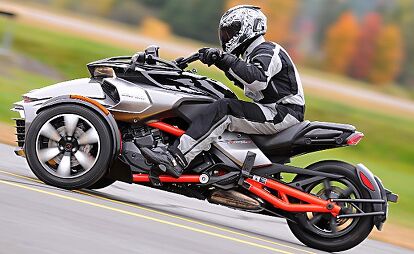


















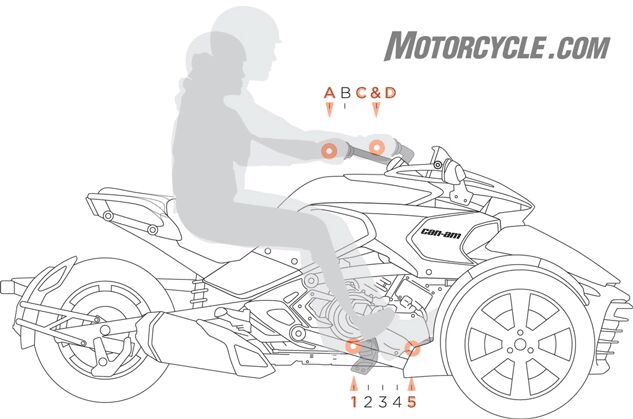











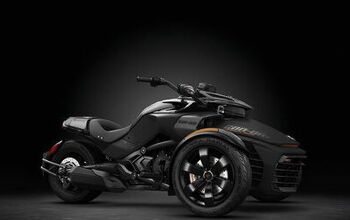

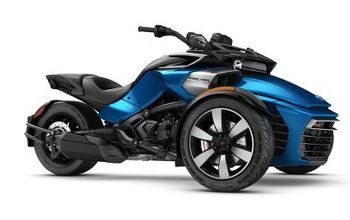
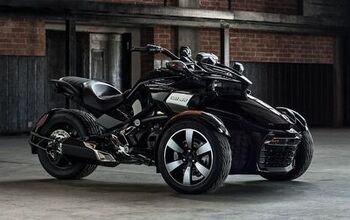













Comments
Join the conversation
I think it's a really new vehicle... they are going to attract some new people that were previously "turned off" by the riding position.
But I disagree with your title... I think this model is MORE like snowmobile than any other spyder models - yes, that's right. It's still not as fast as high-end sleds, but it looks like the "lake racers" of years past. In fact the "ACE" acronym was taken from their Ski-Doo line and the quick-adjustable bars/footrest from another manufacturer.
We bought a 2014 SPYDER RT and we love it. I wish people that write these articles would post 0-60 and 1/4 mile times. I am curious to see how fast the F3 would perform. The rs I have seen drag racing were running low to high 13's. I am glad the F3 removed some of the traction control, even Spyder owners like to have some fun too.